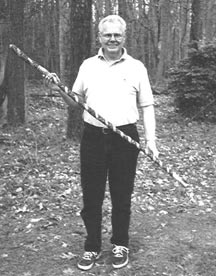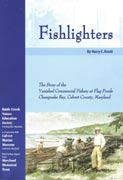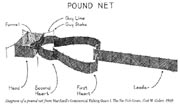Bay Life
Pound Nets and Fishlighters
Flag Ponds is a park with a past. Ranger-detective Harry Knott has dug it up.
by Sara Ebenreck
Two-thirds of the way down the Chesapeake shoreline in Calvert County, where fossil-filled cliffs change to a low, sandy, ever-changing shoreline, lies Flag Ponds, a park with a past.
On April weekends, it’s a great place for wildflower searches, sifting through the shoreline stones to find a shark’s tooth or walking a trail that follows the old dirt wagon-way that was once the major north-south route down the county.
It used to be different. Not so long ago, a thriving Chesapeake pound-net fishery operation had its base camp at Flag Ponds. The outlines of its history are traced in exhibits at the park, but not much was known about the lively details that add zest, humor and human interest to the facts.
It took a former D.C. police officer, now an inquisitive park ranger, to do the detective work of digging out the story of the watermen who worked their livings out of this place.
 Curious Harry …
Curious Harry …
The park ranger-detective is Harry Knott. “I was curious about the fishing shanty exhibit,” he explains, “so I went up to the library and checked for more information. There wasn’t any. But every so often an old man would come in to Flag Ponds and say he used to work there. I’d listen and take a few notes. … Gradually it all began to snowball. I’d end up in a newspaper office tracking down a lead, in a library looking at microfiche or over in Crisfield, trying to find if anyone knew someone named ‘Happy.’ Or ‘Bottles.’”
The curious detective ended up with a high stack of manuscripts, 33 tape-recorded interviews and a collection of photographs, some of them contributed by families of men who’d fished there — facts mixed with stories told by the watermen he’d found or who had found him. Down the road 10 miles or so at Solomons, Calvert Marine Museum maritime history curator Richard Dodds and librarian Paul Berry polished the detective’s work into a book called Fishlighter: The Story of the Vanished Commercial Fishery at Flag Ponds, Chesapeake Bay, Calvert County, Maryland.
Fishlighter is a good spring read, whether you take it in a gulp or slowly, section by section, pondering the stories of a group of men who fished, mended nets, told stories and kept each other cheered and generally healthy over the months of their fishing season.
… and What He Found
“There were basically three crews of men,” says Knott, made up of families who came over from the Eastern Shore: the Duncans, the Todds, the Richardsons and Lloyd Parks. But if one crew got shorthanded, the others would help them out. The goal was to earn the money to support their families, but they had a good time too. … Police and soldiers call that experience being part of a ‘band of brothers’: you’re together all the time and you have to depend on each other.”
The watermen had the skill born of hard, careful work. Pound nets are typically set in water 12 to 20 feet deep. The men had to drive in poles (made from saplings), then set the net (made from cotton twine) in designed sections around the poles. They could drive the stakes and set the net even in fog, remembered waterman Russell Duncan.
Crew captains had to be sharp not only about fish but also about the economic conditions in which they worked. Fish markets then could rise and fall as swiftly as the stock market does today. “If they put out the word that fishing was good, other part-time fishermen would get their permits — and the fish delivered to Baltimore could glut the market and drop prices,” explains Knott. An unusual run of fish could mean the captain had to hire local men on the spot.
Despite, or perhaps because of, harsh conditions, the Flag Ponds watermen built a lode of stories. They told about the copperhead snakes that co-inhabited the outhouse. They told about misfortune, accidents and the foul fish smell of their clothes that could send their cook running out for fresh air. They told about sliding like schoolboys down the 90-foot clay cliffs, just south of the camp, on the seats of their pants.
One of Harry’s favorite stories dates back to the World War II years, when military troops did some training off that beach area. One evening a tank crew ended up needing to sleep over, so the watermen warned them about mosquitoes and invited them into their shanty. “The troops said they were tough and would just stay outside. But after a couple hours, the guys were banging on the door wanting to get inside. By then, the watermen said, the screen door was just black with mosquitoes.”
Like ancient fables, such stories always have a moral. In this case, it’s a lesson about who is really, really both tough and smart.
 What Is a Fishlighter?
What Is a Fishlighter?
When Knott started talking with the watermen, he was puzzled by their regular references to “getting their fishlighter.” It turned out, he says, that fishlighter was their name for a 20- to 30-foot boat they used to bring fish in from the pound nets. Chesapeake watermen had taken the word lighter from the military and shipping term for a smaller boat that helps unload — or lighten — a cargo ship. The watermen added fish to the term, and the boats that carried fish in from the pound nets became fishlighters.
Fishlighters, pound nets and the men who worked with them attracted Eastern Shore artist John B. Moll Jr., who photographed and then made pastel drawings of the scenes. The book cover features one of captains and crew.
Then and Now
Artists and Bay lovers still come to Flag Ponds. Park rangers and assistants carry on the spirit of friendly work as they welcome visitors. Fishermen can still pull a meal or so out of the waters off the pier. Like waterman Russell Duncan, who said, “You could sit in the evenings, sit back and watch the sailing boats come up the Bay,” visitors to the park still sit to look out over the Chesapeake waters to the islands of the Eastern Shore.
 |
Find Fishlighters by Harry C. Knott (110 pages, $8.95) at the Battle Creek Nature Center in the Prince Frederick area and at the Calvert Marine Museum in Solomons. |
The serious work of pound-netting has vanished, but some of the spirit of those watermen stays with the place. Pound nets and their culture connect past to present: Native Americans used them in the Chesapeake, and Bay watermen working other places use them today to catch everything from perch to flounder. In this case, there’s another big difference. Native American needs for fish were limited to the local population. With 21st-century transportation, the voracious appetite of the marketplace for ever-more fish is unlimited. Thus permits now come with strong limits.
Whether you’re fishing or staffing a nature park, “If you’re happy at what you’re doing, it’s going to show,” Knott says.
Then the always-surprising park-ranger reached for something he’s waited until the end of our conversation to show me — a fossil walking-stick — hand carved from a Flag Ponds sapling and covered with sharks’ teeth he’s picked up as he patrols the beach. It’s astonishingly beautiful and unique. On its top sits a seashell. On its stick-bottom, a quarter. “Just so I’ll never be totally broke,” joshes detective Harry.
The watermen are gone, but Flag Ponds keeps drawing more characters with great stories.


 Curious Harry …
Curious Harry …
 What Is a Fishlighter?
What Is a Fishlighter?